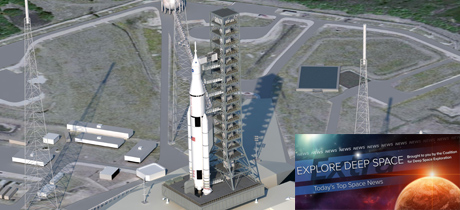In Today’s Deep Space Extra… NASA says current planning calls for modification of the Mobile Launch Platform (MLP) that will support the first Space Launch System (SLS)/Orion mission in 2019 in order to support future flights of an upgraded SLS, rather than build a costly second MLP. Auditors raise new concerns over the launch plans, cost of the James Webb Space Telescope (JWST). United Launch Alliance is poised for the second launch of an advanced U.S. weather satellite on Thursday evening.
Human Space Exploration
NASA no longer seeking to develop second mobile launcher for SLS
Space News (2/28): At NASA’s Kennedy Space Center engineers plan to modify the Mobile Launch Platform (MLP) that is to serve as the launching pad for the first test flight of the Space Launch System (SLS) and Orion rocket, Exploration Mission-1 (EM-1), to prepare it for a second test flight and the first of the SLS and Orion with astronauts on board, rather than manufacture and assemble a second version of the costly platform. That promises to pace the launch of Exploration Mission-2 (EM-2), the first test flight with astronauts. Bill Hill, NASA’s deputy associate administrator for exploration systems development, explained the strategy Wednesday before a gathering of the 45th Space Congress in Cape Canaveral, Florida. EM-1 is planned for 2019.
Washington Post (2/28): Michael “Obie” O’Brien, who oversaw efforts to forge the agreements that led to the birth of the 15 nation, International Space Station, has died. A Navy veteran, O’Brien joined NASA in 1994 in the Cold War’s aftermath and retired in 2015. His death, on February 19, was attributed to cancer.
Space Science
GAO: JWST’S new launch window “likely unachievable,” could bust budget cap
Coalition Member in News – Northrop Grumman
Spacepolicyonline.com (2/28): The James Webb Space Telescope (JWST), a NASA led space observatory with the European and Canadian space agencies as partners, could face delays and cost increases beyond its planned March to June 2019 launch date and $8 billion cost cap, according to a U.S. Government Accountability Office (GAO) audit released Wednesday. Last September, NASA announced the launch of JWST, the successor to the nearly 28-year-old Hubble Space Telescope, could not make an October 2018 launch target. The latest delay is related to the post launch deployment of the telescope’s large sun shield.
United Launch Alliance set to launch GOES-S weather satellite
Coalition Members in the New – Lockheed Martin and United Launch Alliance
Spaceflightinsider.com (2/28): GOES-S, developed for NASA and NOAA by Lockheed Martin, is the second in an advanced generation of space weather and climate research satellites. The launch atop a United Launch Alliance Atlas 5 rocket is scheduled for Thursday at 5:02 p.m., EST, from Cape Canaveral Air Force Station, Florida, Once in geostationary orbit, renamed GOES 17 and checked out, the new satellite will watch over major weather and climate developments affecting the western U.S. It joins GOES 16, which was launched in November 2016 as GOES-R, to watch over eastern North and Central America, including Atlantic hurricane development.
Curiosity tests a new way to drill on Mars
NASA/Jet Propulsion Laboratory (2/28): Engineers at NASA’s Jet Propulsion Laboratory are testing new drilling techniques for the Mars Curiosity Rover, which landed on Mars in August 2012. The drilling hardware encountered a major difficulty on Mars in December 2016, after gathering 15 samples of Martian rock and soil for analysis. Recently, Curiosity was instructed to use the new technique to reach a depth of a half inch as part of a test.
A bus-size asteroid will whiz by Earth Friday
Space.com (2/28): Asteroid 2018 DV1, about the size of a school bus and discovered February 26, will dart by the Earth on Friday from a distance of about 70,000 miles. A close pass from another small asteroid, 2017 VR12, is predicted for March 7.
Cosmic dawn: Astronomers find fingerprints of universe’s first stars
Space.com (2/28): Astronomers led by researchers from Arizona State University examined the Cosmic Background Radiation from the long ago big bang gathered by an observatory in Western Australia in order to seek out the earliest stars ever discovered. The effort detected the signature of a star that formed possibly 180 million years after the big bang. “If you look at our cosmic origins,” ASU’s Judd Bowman told Space.com, “The bottom rung of that ladder is this process of the first objects forming and enriching the medium to make everything else possible.”
Other News
Canada budgets a boost for LEO broadband constellations
Space News (2/28): Canada’s proposed annual budget, presented Tuesday, includes a substantial investment in low Earth orbiting satellites intended to bring internet services to rural parts of the nation.

